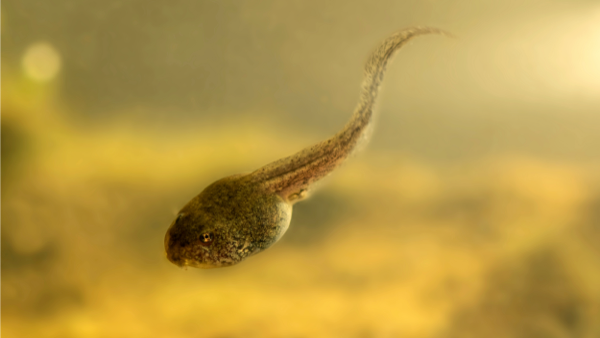Science Lessons for Kids > Animals > Frog & Amphibians
Frog and Amphibian Science for Kids
They start out underwater, and end up above water! Are they coins being fished out of a fountain? No, they’re amphibians, and they won’t be confined! Find out all about nature’s most malleable metamorphs here at Tappity!
5 Amazing Facts About Amphibians for Kids
Want to impress everyone at your next birthday party with cool frog and amphibian facts? Of course you do!
Baby Frogs or Tadpoles Look Like Fish
Frogs start out looking more like fish—as tadpoles, they swim around using a single long tailfin, eating tiny plants in the water. After about 2 months, though, they spend a whirlwind 24 hour day transforming completely into frogs! This process, which all amphibians undergo, is called metamorphosis.
Frogs Breathe Through Their Skin
Frogs breathe air with their lungs, but they can also breathe water through their skin. In fact, that’s why frogs need to be wet all the time - so they can breathe! Most frogs can’t stay underwater forever, but depending on the species, they can stay underwater for anywhere from several hours to a few months. Who knows what they’re doing down there? Frog stuff, probably.
Salamanders Can Regrow Their Tails
If a salamander’s tail is captured by a predator, no worries - salamanders can regrow their entire tail from scratch. They can regenerate more, too: their brain, their heart, and parts of their eyes.
Some Frogs Are See Through
Glass frogs are a kind of frog with transparent stomachs, which lets you see everything inside their body: hearts, liver, intestine, and all! Believe it or not, expert’s believe this is an unusual form of camouflage - because of their see-through legs, the glass frog’s outline is harder to identify, helping it blend into leaves.
The Flying Frog…Can Fly!
Wallace’s Flying Frog has webbed toes, which let it glide from tree to tree, just like a flying squirrel. They live in the canopy of the jungle, at the tops of trees, and their webbed feet allow them to leap long distances without expending too much energy.
Amphibian Trivia for Kids
Test your frog and amphibian knowledge!
-
Both! Amphibians start out as larvae (like a tadpole), with gills, and swim around breathing water. Then when they get older, they transform into their adult form, and breathe the air using lungs! Wow. Can you imagine if you started out life as a water-breathing fish, and only got lungs when you grew up?
-
The GOLIATH frog! The goliath frog lives in the rainforests of Western Africa, and can grow as big as some house cats! Imagine keeping a giant frog as a pet instead of a cat! The flies alone would cost a fortune.
-
The Golden Poison Frog (wonder why it’s called that?) is the world’s most poisonous frog. In fact, it may even be the most poisonous animal, period! A single frog has enough venom on its skin to kill 10 people. It’s meant to keep predators from eating it, but it’s even dangerous just to touch.
-
Frogs’ tongues are sticky to help them catch insects, which they eat. They snap their long tongues out five times faster than the blink of a human eye. The tongues hit their prey hard and fast, so it’s actually really amazing that their prey sticks to it. When the tongue hits their prey, the frog’s saliva is turns liquidy, so that it goes all around the prey. Then, it becomes sticky and gooey, trapping the insect on the tongue.
Also, frog’s tongues aren’t quite as long as they appear in cartoons - usually, they’re about ⅓ the length of the frog’s body. Which is still pretty long - imagine having a tongue down to your belly button!
-
The longest frog jump ever recorded, relative to body size, was by a South African sharp-nosed frog, which jumped 17 feet, 6 inches - about the length of a pickup truck. Could you jump that far? The most amazing part is that the frog was only about 2 inches long, so that means it jumped more than 90 times its own body length. That would be like a fully-grown adult leaping across one-and-a-half football fields.\
-
Surprisingly, some frogs do have teeth! It depends on the species - some have teeth on just the tops of their mouths, a few have teeth on both the top and bottom, and some don’t have any teeth at all. For the most part, frogs with teeth don’t use their teeth to chew - they probably just use it to hold onto their prey after they catch it with their tongues.
-
Frogs mainly eat insects that they catch with their long, sticky tongues. They also sometimes eat snails, slugs, and worms.
-
Male frogs croak to attract female frogs. So when you hear a frog croak, you’re hearing a lonely frog looking for love.
-
Frogs and toads are very similar, but there’s a few ways to tell them apart. The easiest way is by their skin: toads have dry, rough, bumpy skin, while frogs have smooth, moist skin. A toad’s skin is better at holding in water, so they don’t need to keep them wet all the time, like frogs do. That’s also why toads can often be found farther away from water than frogs.
Of course, scientifically, there isn’t an actual category for frogs and toads. People have separated frogs and toads by the way they look, but all of them belong to the Order Anura - it would be scientifically accurate to call every toad a frog.
Kid-Friendly Ways to Learn More About Frogs
Play Tappity’s Interactive Lessons About Amphibians
Want to explore more about frogs and their habitats? Our amphibian video lessons are waiting for you!
Explore More Science Lessons & Topics for Kids
From Volcanoes to Velociraptors, we’ve got it all - right here at Tappity.






















